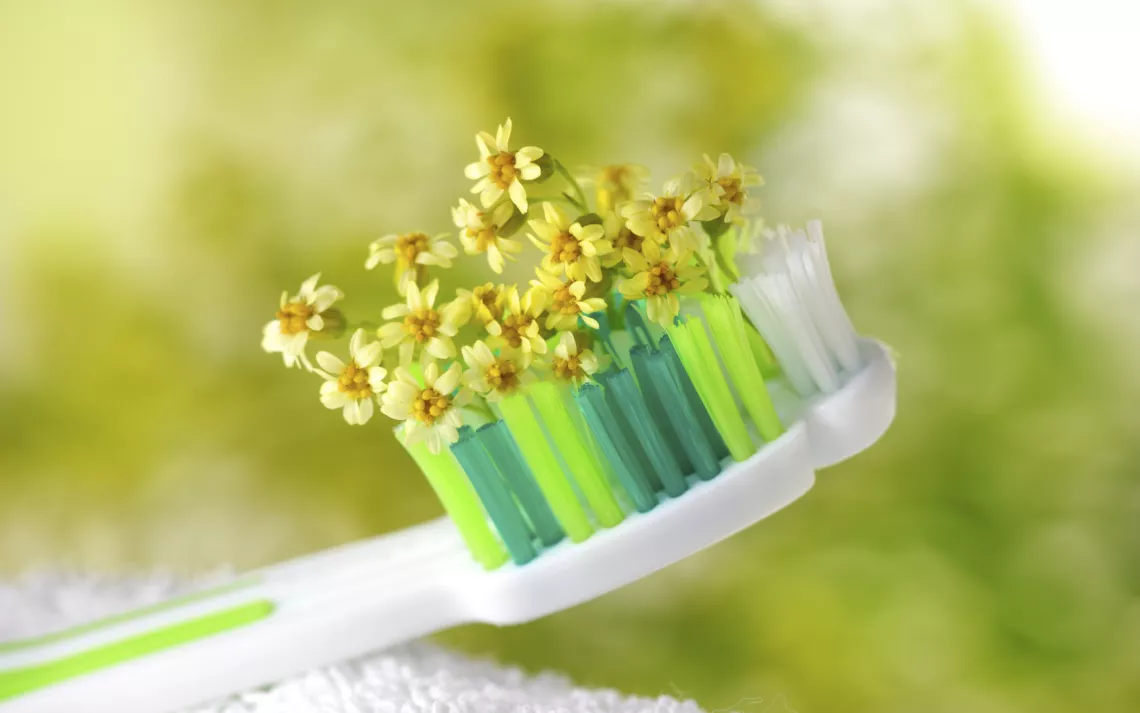What's Hiding in Your Toothpaste?

Photo courtesy of iStock/Anna Omelchenko
A seemingly simple online search for eco-friendly toothpaste can lead to a virtual rabbit hole—with search terms like ‘fair-trade industrial fruit oils’ and enough open tabs to make your browser crash. Why is it so confusing? Any health conscious consumer has the right to wonder what's in their toothpaste, but separating fact from fiction is, well, like pulling teeth. And determining the suppliers that companies use for their raw materials can be nearly impossible. Throw flavor preferences into the mix, and finding a green toothpaste can be a bristly endeavor. Read on for a list of hazardous ingredients that sneak into toothpastes and the brands that manage to avoid them.
MICROBEADS: Not only have the small plastic beads been shown to accumulate in aquatic animals (after they drain down our sinks and into waterways), add them to toothpaste, and they can get trapped in your gums, leading to gingivitis. You’re unlikely to find these in natural-branded toothpastes, but be sure to double-check your preferred supermarket brand’s ingredient list. They can be called polyethylene (PE), polypropylene (PP), polyethylene terephthalate (PET), polymethyl methacrylate (PMMA) and nylon. International campaign Beat the Microbead has an extensive list of plastic-free cosmetics on its website, and even a free app that allows you to scan barcodes to find out if an item contains microbeads. Canada and several states including Illinois and California have already implemented bans, but they might not yet be in effect in your area, so be sure to be vigilant.
Brands Without: All the natural brands avoid microbeads, and many drugstore brands have started phasing them out. The last major holdout is the Crest line.
TRICLOSAN: Triclosan is an antimicrobial and antifungal agent that has become common in soaps, toothpastes, and cleaning products. Its frequent use, like the the over-prescription of medical antibiotics, can lead to the evolution of stronger bacteria capable of resisting antibiotics. Triclosan is added to toothpastes in order to neutralize the bacteria that cause the buildup of plaque on the teeth, yet recent research suggests that it may not deliver on that promise. A study in India pitted an herbal toothpaste against one containing triclosan in a double-blind experiment. After 4 weeks, there was no significant difference between the two in controlling plaque and gingivitis.
In addition, there are concerns that triclosan may act as an endocrine disruptor in humans, and it is known to adversely affect algae when it runs off into watersheds.
Brands Without: Arm & Hammer, Sensodyne, Trader Joe’s line, and all major natural brands such as JASON, Nature’s Gate, Desert Essence, and Tom’s of Maine.
SULFATES: You may have heard about sulfates in the news because people frequently debate their safety. Commonly used substances in this family, such as sodium lauryl sulfate (SLS) and sodium laureth sulfate, show up in so many products because they are surfactant soaps (molecules that disrupt surface tension to aid in cleaning). The EPA lists them as safe, but these chemicals can cause irritation to the skin and mouth in some users. Another unappealing fact—SLS is patented for use as a pesticide.
Even if you’re not concerned about the health effects of SLS and its relatives, there are environmental impacts of their production to consider. Sulfates are derived from fruit oils, and most commonly from palm oil. According to the World Wildlife Foundation, palm oil is the most widely consumed plant oil, popping up in everything from lipstick to sliced bread. To keep up with the demand for the product, vast swathes of tropical forest in Southeast Asia and other equatorial regions have been cut down and turned into palm plantations (it’s the number one cause of deforestation in Indonesia). When forest is replaced by a palm monoculture, the land can no longer support diverse fauna, and ecological processes such as carbon storage are lost.
To avoid supporting this industry, many natural care companies have started using coconut oil derived cleansers like sodium cocoyl glutamate or sodium coco-sulfate. Coconut products are thought to be less environmentally damaging because the trees thrive in sandy soil where not much else grows, and most are cultivated by small-scale producers instead of massive plantations (though this could change). However, the increasing demand for coconuts could lead to destruction of mangrove forests that also occupy sandy shorelines; so to ease your coco-conscious, look for Fair Trade and/or organic certification, and keep in mind that toothpastes that claim to be sulfate-free may still contain different palm oil products (Tom’s of Maine is sulfate-free but contains palm oil glycerin).
Brands Without: Without micro plastics of any kind, antibiotics, or sulfates (and with recyclable packaging), Dr. Bronner’s (its non-sulfate coconut-based ingredients are both Fair Trade and organic) and Uncle Harry’s Natural Products are two of the most eco-friendly lines available. Etsy is a good online source for finding hand-made, natural toothpastes, and you can communicate with the makers for total ingredient transparency.
If none of the above tickle your taste buds, it’s time to make your own toothpaste. It’s easy—with lots of online tutorials—and the best way to make sure what you’re putting in your mouth is on the up and up.
 The Magazine of The Sierra Club
The Magazine of The Sierra Club



